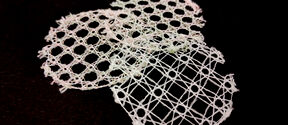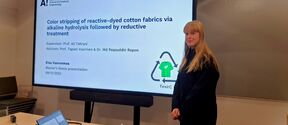Otaniemi, meet A!ex, our autonomous car

Purchased towards the end of spring 2021, the Lexus RX, which came with driver assist technologies as a standard feature, now shines in Otaniemi, surrounded by the many construction sites of the campus area.
‘We ordered a basic system enabling autonomous driving from a US supplier, and can now program and develop it ourselves,’ says Professor Kari Tammi.
‘The car can drive autonomously, but, for now, the presence of a human driver is always required.’
Otaniemi has a long tradition of research and teaching associated with vehicle technology.
The research effort focused on this white Lexus, named A!ex, is only just beginning. Doctoral candidate Risto Ojala and Laboratory Engineer Jesse Pirhonen are responsible for keeping tabs on the additional equipment and software installed in the vehicle.
The car is an excellent subject for further studies.
‘Various research groups want to test different things on it. My task is to make sure the basic system remains operational and that their experiments don’t cross each other’s wires,’ Pirhonen says.
Bringing different research fields together
The Aalto Centre for Autonomous Systems (ACAS) was established in 2019 with funding from the Academy of Finland. The self-driving SUV – a vehicle with autonomous capabilities – is one of the Centre’s spearhead projects.
‘This vehicle enables us to combine many research subjects,’ says Professor of Robotics Ville Kyrki happily.
A!ex is used to research 5G telecommunications and how the car communicates with other vehicles and transport infrastructure. Various research groups are interested in the processing of sensor data and driver assist systems, such as smart cruise control mechanisms.
There is a lot of Finnish interest in remote traffic control and semi-autonomous transport systems. Demand is especially pronounced in the marine shipping and mass transport sectors.
Development has reached an interesting stage also from the perspective of artificial intelligence. At present, autonomous cars still require human intervention in unusual circumstances. The driver can assume control of A!ex through the steering wheel or pedals, in addition to which the car has an emergency off switch.
As a human is still required to sit behind the wheel, researchers are particularly keen to develop remote steering.
In future, the distance between drivers and the vehicles they control, for example a set of earthmoving machines, may be measured in kilometres. A combination of autonomy and remote control could enable distance operators to assign tasks to vehicles.
Finnish weather a benefit for once
Autonomous cars are already moving about under the California sun, but exceptional situations and various weather conditions continue to cause problems.
‘Here in Finland and Otaniemi in particular, we’re focusing on how autonomous systems behave in different weather and lighting conditions as well as on various types of road,’ Kari Tammi says.
‘Sensor technology is easily confused by horizontal sunlight and reflections.’
Ville Kyrki says that we should not think of fully autonomous and semi-autonomous systems as opposites.
‘Autonomy is no problem in limited situations. Also here in Otaniemi we have seen A!ex move around quite straightforwardly in good conditions. Its AI is clever, but not yet sensible.’
Changes in the weather and seasons require software development that enables the car to, for example, identify a tree as being the same when it is fully covered by verdant leaves and when under a coating of snow. Researchers are interested in how sensor data can be interpreted irrespective of the weather.
What if the network is down?
A key research question in remote control is the reliability and data security of telecommunications as well as the division of responsibility between the remote controller and the system. What to do if the connection drops just as the remote controller hits the accelerator on the other side of the globe?
‘The car has to be safe also when networks are down or being interfered with,’ stresses Communication Engineering ProfessorRiku Jäntti, who heads the ACAS research unit.
Jäntti says ultra-fast 5G networks are a prerequisite to autonomous transports. Effective connections enable improved security and more fluid traffic.
‘The research being carried out with A!ex will serve more than just cars and traffic infrastructure. The same technologies are used in, among other things, forest machines,’ Professor Kari Tammi points out.
‘Finnish industry is familiar with autonomous solutions. They have been developed for port cargo handling equipment, mining vehicles and forklifts. We want to collaborate with industry as well.’

Text: Niina Norjamäki
Photo: Kalle Kataila
This article was published in the Aalto University Magazine issue 29, October 2021.
Read more news

Smart textiles are reshaping our understanding of materials – and interspecies communication
The PAST-A-BOT research project, funded by the European Research Council (ERC), is developing soft, intelligent textiles that could one day function as rescue robots, sound-sensing agricultural fabrics, or assistive clothing. At the same time, the project aims to rethink the way we approach materials research.
Master’s student showcases efficient color stripping of cotton fabrics
On December 9, master’s thesis student Elsa Vuorenmaa from the Textile Chemistry Group presented the results of her research on color stripping of reactive-dyed cotton fabrics.
Future makers research batteries, cryptography and plastic recycling
The Technology Industries of Finland Centennial Foundation awarded 3.5 million euros in research funding to eight projects, five from Aalto University.






